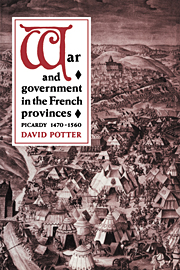Book contents
- Frontmatter
- Contents
- Acknowledgements
- List of abbreviations
- Notes on transcriptions of documents, units of money and measures
- Introduction
- 1 Return to allegiance: Picardy and the Franco-Burgundian Wars, 1470–93
- 2 The provincial governors and politics
- 3 The governors' staff and household
- 4 The Picard nobility and royal service
- 5 Military organisation in Picardy during the Habsburg–Valois wars
- 6 ‘Les fruictz que la guerre rapporte’: the effects of war on the Picard countryside, 1521–60
- 7 War, taxation and the towns
- 8 Peace negotiations and the formation of the frontier in Picardy, 1521–60
- Conclusion
- Appendices
- Bibliography
- Index
3 - The governors' staff and household
Published online by Cambridge University Press: 06 October 2009
- Frontmatter
- Contents
- Acknowledgements
- List of abbreviations
- Notes on transcriptions of documents, units of money and measures
- Introduction
- 1 Return to allegiance: Picardy and the Franco-Burgundian Wars, 1470–93
- 2 The provincial governors and politics
- 3 The governors' staff and household
- 4 The Picard nobility and royal service
- 5 Military organisation in Picardy during the Habsburg–Valois wars
- 6 ‘Les fruictz que la guerre rapporte’: the effects of war on the Picard countryside, 1521–60
- 7 War, taxation and the towns
- 8 Peace negotiations and the formation of the frontier in Picardy, 1521–60
- Conclusion
- Appendices
- Bibliography
- Index
Summary
What was the area over which the provincial governors exercised their authority? Godard, in 1949, put the case aptly when he said that ‘au cours des guerres, le mot Picardie avait pris un sense militaire, mais restait extrèmement imprécis’. It was indeed military necessity which shaped the province and, in the first half of the sixteenth century, there were still enclaves and exemptions which rendered a clear geographical definition of the province difficult. By 1560, however, custom was beginning to introduce a greater degree of clarity.
In the reign of Louis XI, the governor's powers covered at first only that part of the Somme region which owed allegiance to the king of France – the ‘marches de Picardie’ – but the reconquests of the 1470s naturally led to an extension of that authority. In addition, new territory seems to have fallen within the governor's sphere with the acquisition of the county of Boulogne and large parts of Artois. Even though Charles VIII formally abandoned his claims to Artois in 1493, certain enclaves remained under French jurisdiction (the most important of which was Thérouanne) and for this reason the governors were still in 1560 entitled ‘lieutenant-général du roi en Picardie et Artois’.
The exact status of Boulogne might seem ambivalent. Later in the ancien régime, the county had a governor of its own but, throughout the sixteenth century, the sénéchal and governor there were always subordinated to the governor of Picardy, though until 1494 these were the same in the person of the marshal d'Esquerdes.
- Type
- Chapter
- Information
- War and Government in the French Provinces , pp. 92 - 112Publisher: Cambridge University PressPrint publication year: 1993



